Replaces
1999 Mercury Grand Marquis Front 10 Piece Steering & Suspension Kit TRQ PSA59756
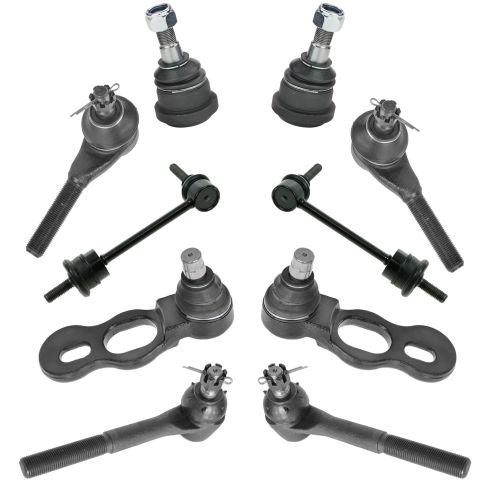

PSA59756
In Stock
This part doesn’t fit a . Select from parts that fit.
Specify your vehicle's year, make and model to guarantee fit.
Orders must be placed by 2pm ET
You may also like
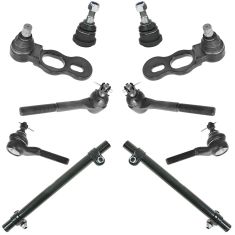
10 Piece Steering & Suspension Kit
$99.95
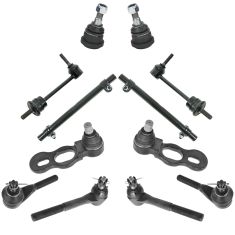
12 Piece Steering & Suspension Kit
$109.95
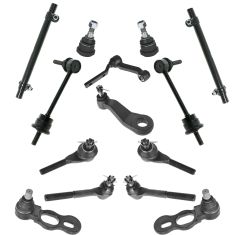
14 Piece Steering & Suspension Kit
$134.95
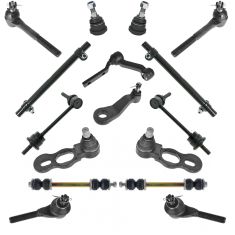
16 Piece Steering & Suspension Kit
$144.95
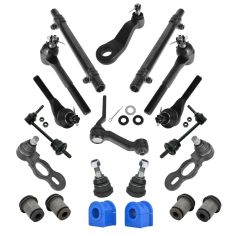
20 Piece Steering & Suspension Kit
$164.95
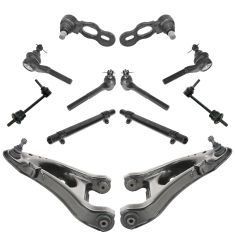
12 Piece Steering & Suspension Kit
$274.95
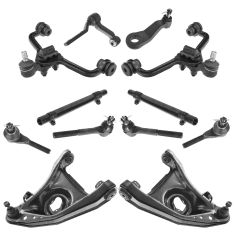
12 Piece Steering & Suspension Kit
$369.95
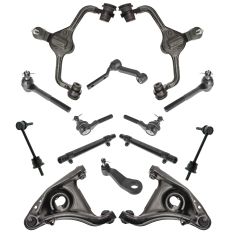
14 Piece Steering & Suspension Kit
$384.95
Part Details
- Quantity: 10 Piece
-
Kit Includes:
(2) Front Lower Ball Joints
(2) Front Outer Tie Rods
(2) Front Sway Bar Links
(2) Front Upper Ball Joints
(2) Front Inner Tie Rods
Specification
- Front
TRQ suspension kits are manufactured using premium raw materials and coatings for extended service life. Each TRQ suspension component is designed to be a direct, maintenance-free replacement to the stock unit. To extend the life of your steering and suspension components, TRQ recommends replacing components in pairs, sets, or kits. All products are fit and road-tested in our Massachusetts R&D facility to ensure we deliver on our promise of Trusted Reliable Quality.
Product Features
Install Tip: When replacing steering components, have a professional alignment performed afterwards. This ensures proper tracking and even tire wear.
Our steering and suspension components are pre-greased and sealed for long life and do not require the extra maintenance typically required by greaseable versions.
Item Condition:
New
Attention California Customers:
![]() WARNING: This product can expose you to chemicals including Lead and Lead Compounds, which are known to the State of California to cause cancer, and birth defects or other reproductive harm. For more information, go to www.P65Warnings.ca.gov.
WARNING: This product can expose you to chemicals including Lead and Lead Compounds, which are known to the State of California to cause cancer, and birth defects or other reproductive harm. For more information, go to www.P65Warnings.ca.gov.
Lifetime Warranty
This item is backed by our limited lifetime warranty. In the event that this item should fail due to manufacturing defects during intended use, we will replace the part free of charge. This warranty covers the cost of the part only.
FREE Shipping is standard on orders shipped to the lower 48 States (Contiguous United States). Standard shipping charges apply to Hawaii and Alaska.
Shipping is not available to a P.O. Box, APO/FPO/DPO addresses, US Territories, or Canada for this item.
Expedited is available on checkout to the United States, excluding Alaska, Hawaii.
Final shipping costs are available at checkout.





Created on:
Tools used
- Pry off the center cap with a flat blade screwdriver Loosen the lug nuts with the vehicle on the ground Raise the vehicle with a floor jack Secure the vehicle on jack stands Remove the lug nuts Pull off the wheel
- Turn the brake rotor by hand or turn the steering wheel to turn the rotor Remove the cotter pin from the tie rod nut using pliers Remove the 19mm bolt from the tie rod end Loosen the 1/2 inch nut and bolt from the tie rod adjusting sleeve Attach the tie rod press tool to the steering knuckle Use the tie rod press tool and a wrench to separate the tie rod end from the steering knuckle Apply penetrating oil to the tie rod adjusting sleeve Measure the distance from the end of the adjusting sleeve to the end of the tie rod Note this measurement Loosen the tie rod from the adjusting sleeve with an adjustable wrench Pull out the tie rod
- Thread the new tie rod into the adjusting sleeve Measure the distance from the end of the adjusting sleeve to the end of the tie rod This measurement should match the one noted in Step 2 Insert the tie rod into the steering knuckle Start the 19mm nut onto the tie rod Tighten the 19mm nut to between 40 - 45 foot-pounds of torque Turn the nut further to line up the space for the cotter pin Put the cotter pin into place Bend the cotter pin with pliers Tighten the 1/2 inch nut and bolt to 20 - 21 foot-pounds
- Slide the wheel into place Start the lug nuts by hand Tighten the lug nuts preliminarily Lower the vehicle to the ground Tighten the lug nuts to between 100 - 110 foot-pounds in a crossing or star pattern Reattach the center cap Have the vehicle professionally aligned
Brought to you by 1AAuto.com, your source for quality replacement parts and the best service on the Internet.
Hi, I'm Mike from 1A Auto. I hope this how-to video helps you out, and next time you need parts for your vehicle, think of 1AAuto.com. Thanks.
In this video, we're going to do an outer tie rod end on this 2000 Crown Vic, very similar for any of this era of Crown Vics as well as the Town Cars. As far as alignment goes, it's recommended that you have your car aligned after you do a job like this, but if your car is still steering straight down the road, the steering wheel is still centered, then the alignment can be at your discretion. Tools you'll need are jack and jack stands, and 19mm socket and ratchet. You'll need a 1/2 inch socket and ratchet and also 1/2 inch wrench, some needle nose pliers, penetrating oil, and a torque wrench.
Raise and support the vehicle and remove the cap, and then remove the lug nuts. If you don't have the luxury of having air tools, you want to loosen the lug nuts while the vehicle is on the ground, the wheel is on the ground. Then, raise and support the vehicle. Remove the lug nuts the rest of the way, and remove the wheel and tire.
You can pull the steering over or turn the steering wheel, so it's easier to access the end of the tie rod. In this shot, the green arrow points to the tie rod and the red arrow points to the steering knuckle. In the next scene, I'm going to shake the front steering a little bit, and what you'll see is that the steering knuckle, again, with the red arrow, moves more than it should, which indicates play in the tie rod. This is how you want to look for whether or not you have a bad tie rod. That's a little difficult to see, so you might want to rewind it a couple times, but you'll see that that steering knuckle that the red arrow is pointing to moves more than the tie rod end.
Next, you want to remove the cotter pin. Hopefully, you can just kind of straighten it out, break off the ends that are bent over, and it will pull out. Mine proves to be more difficult. What I end up doing is just breaking off as much of the pin as I can, and then, I put my wrench on it, and it takes a little bit of pulling but basically the bolt just shears the cotter pin right off after you've gotten most of it broken off. It's a 19mm bolt. Here, I'm going to loosen up the nut and bolt that hold the adjustment sleeve onto the tie rod end, and those are 1/2 inch tools believe it or not. Just standard size 1/2 inch socket and wrench. Now, here I'm putting the tie rod press tool onto the steering knuckle, and tightening it down in preparation for using my impact wrench. You can also just use a regular wrench for this. Now, coat the tie rod end and adjusting sleeve with a good amount of penetrating oil to loosen it up. Let it sit for a little while. Then, you take a measurement on the bottom side from the end of the sleeve right after the end of the tie rod. You get 3-1/4 inches, right out to the end. I'm going to speed it up here. I'm just taking a big adjustable wrench and pulling on to that tie rod end, getting it to move and spin. Then, you actually, on the driver side, turn it clockwise to remove it.
Put the tie rod in. Speed it up as I thread the new tie rod end from 1A Auto in. You can see here I'm using my tape measure, measuring it. For this car, it's a 3-1/4 inches from the end of the sleeve to the end of the tie rod. That will vary by car. If you set it up the same as you took it apart, it should be okay as far as your alignment. That's kind of up to you. If you drive the car and it still goes nice and straight and the steering wheel's straight, then you'll be all right. If it's pulling at all or the steering wheel is not straight, then have it aligned. Then, you insert the tie rod into the steering knuckle. You've just got to work it around a little bit, get it up in there, and then start the bolt on. Tighten this to 40 to 45 foot-pounds. Then we will go a little bit further just to get the cotter pin through. You can see I used the wrench just to tighten it just a little bit more so that cotter pin goes through nice and easy. Then, use pair of needle nose pliers to bend the cotter pin over. Now, tighten up the bolt and nut that pinch the adjusting sleeve to 20 to 21 foot-pounds.
Now, put your wheel back on, and yes I know this is the other side. This is the footage I had, but obviously the procedure is the same for either side. You want to put your wheel back on once you're done replacing the tie rod. Put the lug nuts on by hand first. Tighten them up primarily with your wrench or impact wrench and then let the vehicle down on the ground. Tighten the lug nuts to anywhere from 100 to 110 foot-pounds and use a star pattern as you're tightening them and then put the center cap back on, and you should be all set.
We hope this video helps you out. Brought to you by www.1AAuto.com, your source for quality replacement parts and the best service on the Internet. Please feel free to call us toll-free, 888-844-3393. We're the company that's here for you on the Internet and in person.
Tools used
- Pry off the center cap with a flat blade screwdriver Loosen the lug nuts with the vehicle on the ground Raise the vehicle with a floor jack Secure the vehicle on jack stands Remove the lug nuts Pull off the wheel
- Turn the rotor by hand or turn the steering wheel to access the tie rod Remove the cotter pin from the tie rod nut with needle nose pliers Loosen the 19mm nut from the tie rod end Loosen the 1/4 inch nut and bolt from the tie rod clamp Apply penetrating oil to the tie rod end Separate the tie rod from the steering knuckle with a pickle fork and hammer If a pickle fork is not available, remove the 19mm nut from the tie rod end Then thread the nut on upside down and separate the tie rod from the steering knuckle with a hammer Mark the outer tie rod threads with a marker where they meet the inner tie rod Twist off the outer tie rod with an adjustable wrench
- Measure the distance from the end of the old tie rod to the marked threads Mark the new tie rod in the same location
- Remove the shipping boot Twist the new outer tie rod into place Clean the steering knuckle Push the outer tie rod into the steering knuckle Thread the 19mm nut onto the tie rod end Tighten the 19mm nut to 50 foot-pounds of torque Line up the nut with the cotter pin hole Insert the cotter pin into place Bend the cotter pin with needle nose pliers Insert the 1/4 inch nut and bolt into the tie rod clamp Tighten the 1/4 inch bolt to between 20 - 25 foot-pounds
- Slide the wheel into place Start the lug nuts by hand Tighten the lug nuts preliminarily Lower the vehicle to the ground Tighten the lug nuts to 100 foot-pounds in a crossing or star pattern Reattach the center cap
Brought to you by 1AAuto.com, your source for quality replacement parts and the best service on the Internet.
Hi, I'm Mike Green. I'm one of the owners of 1A Auto. I want to help you save time and money repairing or maintaining your vehicle. I'm going to use my 20-plus years experience restoring and repairing cars and trucks like this to show you the correct way to install parts from 1AAuto.com. The right parts installed correctly: that's going to save you time and money. Thank you and enjoy the video.
In this video, we're going to show you how to replace the outer steering tie rod end on this 2000 Lincoln Town Car. It's actually the same as any '81 to 2002 Town Car. Tools you'll need are 13/16 inch and 19 millimeter sockets with a ratchet, a torque wrench, pliers, tie-rod separator fork, hammer, ruler, and a marker or a grease pencil.
We're going to start out. Remove your center cap. If you're using hand tools you'll want to loosen your lug nuts while the wheel's on the ground first, then raise the car with the jack stand, and then remove your lug nuts. I have the benefit of air tools. These are 13/16 inch lug nuts. We'll just speed it up here as we remove those lug nuts and then remove the wheel entire.
Pull or turn your steering wheel so you can have easy access to the tie rod. Apologies here, I didn't get a very good shot of it, but all I'm doing is using a pair of needle nose pliers to break off the ends of the cotter pin, and then pull it out of the tie rod stud. This bolt's 19 millimeters. We'll speed it up here a little bit as we just remove that bolt the rest of the way. Now, right here, on the steering linkage there's a bolt with a nut on the back side that holds a clamp. It's a half inch, which I'm surprised about. It can seem to bounce back and forth between metric and standard, but we want to loosen up this bolt.
Now, we're going to hit the end of the tie rod end with a lot of penetrating oil. Now we want to separate the tie rod end from the steering knuckle. There are two ways you can go about this. The best way is using the correct tool which is a tie rod and ball joint separator, sometimes called a pickle fork. The other way is you could take your bolt, thread it back on, actually, upside down onto your tie rod end, and then use a hammer to try to force it out. That bolt keeps the tie rod stud from mushrooming and then not being able to go through here, so you'd want to make sure you get the bolt down level with the stud, and then beat on it. This is not always successful. It can cause stress to your steering knuckle, so it's not a hundred percent recommended. Also, if you do it this way, you probably will have problems getting this bolt back off because it will get stuck onto the stud. The right way is with a pickle fork. I do make a minor mistake here. You see I took that nut off. You actually want to loosen that nut and leave it on. You'll see later so that when you do break the tie rod loose the pickle fork doesn't fall and the tie rod or the steering linkage doesn't fall. It's not a big deal, but just a little safer way to do it is to leave that bolt threaded on there so it doesn't come apart too violently. You can see there's an ear on this side which means they want you to go at it just like this. This is one of those times when it's fun not to be nice. I don't have a lot of room here.
So, now what I'm going to do is use a red permanent marker, you can use anything. I mean grease pencil or something would be best. I'm going to really put a bunch of red ink there. That's going to tell me how far in the tie rod was. Now, I'm going to take a large adjustable wrench, and, on these tie rods, clockwise actually is moving them out, so you want to basically just start turning, and this one actually started turning pretty easy.
We'll measure from the end here. I would say it's about eight and three quarters centimeters. For this one, down here, do the same and mark. This'll just give you a rough alignment. After this repair, you should have your car aligned.
Remember on this side it's counterclockwise you can install it. Then up to my mark and one more. Remove the nut. That plastic is a shipping boot, so we want to remove that. If you have paper towels, clean off. Clean out the steering knuckle. I'm just going to push the new tie rod. It's going to be stiff. Push it a little bit. Work it up in there. Get the nut on. Now, we need to torque our nut on here. I've got the torque wrench set to 50 foot-pounds. Then at a brief look, it looks like you pull it just a little tighter to get the cotter pin into it. I'll need a cotter pin. Put it in from the side here. It just needs a little convincing. It's got to get up and over. It doesn't go anywhere. Briefly tighten this bolt here. When I get this tight, it probably should be about 20 to 25 foot pounds. I'm just going to get it pretty tight with my ratchet here.
Now we're going to fast forward through putting the tire back on, thread the lug nuts on by hand. I use my impact wrench just to tighten them preliminarily, and then lower it down to the ground. Torque them to 100 foot-pounds using a star pattern, and then put my center cap back on.
We hope this video helps you out. Brought to you by www.1AAuto.com, your source for quality replacement parts and the best service on the Internet. Please feel free to call us toll-free, 888-844-3393. We're the company that's here for you on the Internet and in person.
Tools used
- Lift and secure your vehicle with its model specific safe support points. Make sure your jack stands are set and the correct height on an even surface and your e brake is on if all four wheels aren’t off the ground.
- Use a wrench to remove the nuts on the top and bottom of the stabilizer link. Use a second wrench to add leverage to the first one you are using. Secure the stabilizer link with the adjustable wrench to secure a Torx bit to remove the nuts the rest of the way with your wrench. Continue finessing the wrenches and Torx Bit till your successfully work the stabilizer bar out. Remove the stabilizer link.
- Thread the stabilizer link, bushings and washers into the steering knuckle and sway bar. Use your wrenches to secure the link and a socket and ratchet to tighten it up.
- Put the wheel on and hand tighten the lug nuts. Lower the vehicle and torque the lug nuts in a star pattern to 100 ft lbs.
Brought to you by 1AAuto.com, your source for quality replacement parts and the best service on the Internet. Hi, I'm Mike Green. I'm one of the owners of 1A Auto. I want to help you save time and money repairing and maintaining your vehicle. I'm going to use my 20 plus years experience restoring and repairing cars and trucks like this to show you the correct way to install parts from 1AAuto.com. The right parts installed correctly. That's going to save you time and money. Thank you and enjoy the video.
In this video, we're going to show you how to replace the stabilizer, or sway bar end link, on this 2000 Lincoln Town Car, same as any '98 to '02. Tools you'll need are a 13/16th socket and ratchet or your tire iron, jack and jack stands, 15 and 18mm wrenches, T40 Torx bit, an adjustable wrench, and a quarter inch wrench or whatever size to grab on to that T40 Torx bit. We're going to start off. Remove your center cap. If you're using hand tools, you'll want to loosen your lug nuts while the wheel's on the ground first then raise the car off the jack, secure it with the jack stand, and then remove your lug nuts. I have the benefit of air tools. These are 13/16ths lug nuts. We'll just speed it up here as we remove those lug nuts and then remove the wheel and tire. Pull or turn your steering wheel so you can easy access to the tie rod. In order to remove your stabilize link, you then do 2 bolts, one here that is a 18mm and one up here that's a 15mm. What I do on bolts like this that you can only get to with a wrench, put a wrench on it. Then you can hook another wrench on and then carefully push. Gives us more leverage. Loosen it up, same thing down here.
Same thing down here. I'll put this wrench on. I'm going to be pulling this one. I'm going to hook my other wrench. I'm going to pull carefully while it moves. I believe it looks like the whole shaft is spinning. Most likely, this stud is going to spin on you. I going to put the ... and you see right there the wrench is moving and that stud is moving as well. Put the wrench on. This is a T40 Torx bit. I have to give the Lincoln engineers a little bit of grief because this is difficult. They probably have some special tool. Got that T40 Torx bit on there. Now I'm going to put my adjustable wrench on. Tighten it up as much as I can. Now that Torx bit just want to get that one on better here. Sorry you can't really see that probably, but this wrench is holding that Torx bit so I can then spin this here. Eventually it will come apart. What I'm going to have to do is pull this back off, now that it's loose. I'm going to coat this bolt with penetrating oil. 15mm wrench. On this one, I'm going to use a punch. Just punch that right out. Now to continue, I got a quarter-inch wrench here, which is the same size as my Torx bit. I'm going to feed my Torx ... I'm actually going to put my quarter-inch wrench in there, feed my Torx out through the wrench and into the tie rod. I didn't start with this because of the angles.
This actually didn't really work. I had to put it up in there and grab it with the adjustable wrench. Now it does, so I just let the quarter-inch wrench go there. It holds it and I just take the nut off. There's your link out. It's a new link from 1A Auto. You can see it has grease-able fittings. I'm going to put it down in at the bottom first, so get the bottom through. Start my larger nut on and now the top. I'm going to force that into the knuckle. Putting it together is much easier because the link is nice and tight. You can just tighten up the bolts with your wrenches. They probably have Torx specifications, but if you get them nice and tight with the combination wrenches, you'll be good enough. We tighten up the lower one and then tighten up the upper one. Now we're going to fast forward through putting the tire back on. Thread the lug nuts on by hand. I use my impact wrench just to tighten them preliminary then lower it down to the ground, Torx them to 100 foot-pounds using a star pattern, and then put my center cap back on.
We hope this helps you out. Brought to you by www.1AAuto.com, your source for quality replacement parts and the best service on the Internet. Please feel free to call us at toll free, 888-844-3393. We're the company that's here for you on the Internet and in person.
Tools used
- Pry off the center cap with a flat blade screwdriver Retrieve the center nut key from the glove box Remove the center nut with key Pry off the wheel cover Loosen the lug nuts with the vehicle on the ground Raise the vehicle with a floor jack Secure the vehicle on jack stands Remove the lug nuts Pull off the wheel cover bracket Pull off the wheel
- Apply penetrating oil to the stabilizer link bolts Loosen the 15mm bolt on the top of the stabilizer link Loosen the 18mm bolt on the bottom of the stabilizer link Put a 5mm Allen wrench into the lower stabilizer link bolt Hold the Allen wrench as you remove the lower bolt Remove the 15mm bolt from the top of the stabilizer link Drive the top of the stabilizer link out of the steering knuckle with a hammer and chisel Pull off the stabilizer link
- Install the grease fittings into the new stabilizer link Push the bottom of the stabilizer link into place Raise the lower control arm with a jack Push the upper stabilizer bar stud into the steering knuckle Thread the 15mm nut onto the top stabilizer bar stud Tighten the 15mm nut to 50 - 55 foot-pounds Thread the 18mm nut onto the lower stabilizer bar stud Tighten the 18mm nut to 65 - 70 foot-pounds
- Slide the wheel into place Put the wheel cover bracket into place Start the lug nuts by hand Tighten the lug nuts preliminarily Lower the vehicle to the ground Tighten the lug nuts to 100 foot-pounds in a crossing or star pattern Put the wheel cover on Insert the center nut into the wheel cover with the key Reattach the center cap Return the center nut key to the glove box
Brought to you by 1AAuto.com, your source for quality replacement parts and the best service on the Internet.
Hi, I'm Mike from 1A Auto. I hope this how-to video helps you out, and next time you need parts for your vehicle, think of 1AAuto.com. Thanks.
In this video, we're going to replace a front stabilizer bar link on this 2000 Mercury Grand Marquis, pretty much the same process for a '98 to 2011 Grand Marquis or Ford Crown Victoria. We do the passenger side. Obviously the driver side is the same procedure. We do recommend that you replace these in pairs. Tools you'll need are Jack and Jack Stands, your tire iron or 21mm Socket with a breaker bar, basically what you need to get the wheel and tire off, 15mm and 18mm wrenches and a 5mm Allen wrench.
Start out by removing the wheel cover. You pry off the center cap then there should be a key somewhere in your car, in the glove compartment. Remove the center nut and then pry the wheel cover off. If you don't have air tools, you'll want to loosen the lug nuts with the wheel on the ground. Then, raise and support the vehicle. We'll loosen them. I'm going to fast forward here as I just remove those lug nuts. Set aside that bracket that holds the hub cap and take the wheel and tire off.
The stabilizer bar is held on, right there, with the bolt. I'll put some penetrating oil on it. There's another bolt down here. On top is a 15mm. I like to put the wrench on there and take another wrench, hook it right in. It's a little tight to get a socket and ratchet on there. We're actually on there with this method. It gives you more leverage. Nice and slow. The bolt should come loose pretty easily. This bolt in here is an 18mm. Do kind of the same thing. Get the wrench on it. Put my 17mm wrench on and pull. Nice and easy. It starts to move. I'm going to look at the stud and see if it's moving. It's starting to move. I'm going to come up through this hole with the 5mm Allen wrench. Put that in there. I'm going to speed up here as I just keep working that wrench with the Allen wrench holding it. It will get difficult to hold that Allen wrench so I'm just giving a shot underneath. I stick a wrench on there to hold the Allen wrench, to give you some more leverage. Just keep fast forwarding here as, like I said, I just work that bolt right off. We'll keep the high speed action going, here, as we go back up to the top and remove that bolt the rest of the way. I go back to using the wrench for some extra leverage as that bolt gets a little more difficult to remove as it gets farther off the stud. I just want to take . I'm using a chisel, and some type of impact tool to drive the top out. It's coming through so far. I'm just using a smaller extension here, to get it the rest of the way out.
The new link from 1A Auto is much easier to use. It has a nut here that you can grab on to with the wrench. This makes it a lot easier to put in. You may want to put in a grease fitting here and a grease fitting down here. Those come with it. Just use a small wrench to put them in. They're already installed. This one points up and away so that's easy to get grease in there.
Here, I basically take the bolts off first, and then, you want to get the bottom in first. What you might need to do is just grab hold of the stud on the bottom and position it so you can get it into the stabilizer bar. Now, use a jack and jack up the lower control arm until you get into a position where you can work the upper stud into the top of the steering knuckle. You can remove your jack and put on the nut on the upper side and use your 15mm wrench to tighten it up and then grab on to a larger wrench, give yourself some extra leverage and get it nice and tight. You don't have to get it incredibly tight. It probably has specifications, around 50-55 ft-lbs but it's pretty hard to get it to work down there so just use a wrench and get it nice and tight. Do the same thing with the lower nut. I was pleasantly surprised on the 1A Auto part, the lock nut was able to go on and it didn't make the stud twist. I was able to get it on, tighten it up and these probably tighten to a spec of 65-70 ft-lbs. It's pretty tough to get any kind of a torque wrench on there. I just got it nice and tight with the wrenches that I had.
Put your wheel and tire back on. Start all the lug nuts with the little bracket for the wheel cover and just preliminary tighten them with the impact wrench or your socket and ratchet. With the wheel on the ground, use a torque wrench and tighten them to about a 100 ft-lbs using a star pattern then put your wheel cover back in place. Put the center safety bolt back in, tighten it up, make sure it's all on there good. Always make sure you put your key back in the glove compartment.
We hope this video helps you out. Brought to you by www.1AAuto.com, your source for quality replacement parts and the best service on the Internet. Please feel free to call us toll-free, 888-844-3393. We're the company that's here for you on the Internet and in person.
Tools used
- Loosen the lug nuts with a lug wrench or 19 mm socket and ratchet. Raise and secure the vehicle. Remove the lug nuts and wheel.
- Secure the frame of the vehicle. Jack up the control arm/suspension of the car. Mark your inner and outer cams to help align your vehicle during assembly. Remove the 22 mm bolts and remove the inner and outer cams.
- Remove the 18 mm nut and remove bolt. Remove the upper ball joint.
- Fit the ball joint into the steering knuckle and over the control arm studs. Work the upper ball joint into place. Bolt down with the 18 mm ball joint locking nut. Put your cams down on the control arm studs and thread on the locking nuts. Line up your marks on the cams and tighten down the lock nuts the rest of the way. Tighten up the pinch bolt to 90 ft lbs. Torque the control arm nuts to 118 ft lbs. Insert your grease fitting and fill with the grease gun.
- Hand tighten your lug nuts Lower the suspension and the vehicle. Torque your lug nuts in a star pattern to 100-110 ft lbs.
Brought to you by 1AAuto.com, your source for quality auto replacement parts and the bets service on the internet. Hi, this is Mike from 1A Auto. I hope this how to video helps you out. Next time you need parts for your vehicle, think of 1AAuto.com. Thanks.
In this video, we're going to show you how to replace an upper ball joint on this 2000 Ford Crown Victoria. This process is the same for any '95 to '02 Crown Victoria or Lincoln Town Car. You'll know if your ball joint is getting loose, what you do is you jack up the front of the vehicle and you'll feel some play in the top of the wheel, if you try and shake the top of the wheel back and forth, you'll feel it give a little bit and the bottom doesn't give. That's the indication that your upper ball joint is bad. Tools you'll need for this repair are jack and jack stands, 18 to 22 millimeter sockets with a ratchet and extension. You'll need a breaker bar or pipe for some extra leverage for some of these bolts, a screwdriver, a tool to mark the alignment cams, you'll see what I mean, I use a hammer and a cold chisel then you'll need a large adjustable or 34 millimeter wrench, a grease gun and grease, and a torque wrench. Start by removing the front wheel.
Pry the cap off and then if you don't have air tools, you want to loosen the log nuts then raise and support the vehicle and remove the lug nuts the rest of the way and remove the wheel and tire. Make sure you support the vehicle onto the frame just like the lift is there. Put a jack stand there. Now, use a fore jack to support the vehicle under the front suspension. Your ball joint is mounted right here. You'll see the large nuts on top and then these here are tall alignment cams and if you turn them; that's how you align the vehicle. What you want to do is mark your alignment cams with the suspension so that you can put it back together the same. What I basically do is take this ad on and then mark it right here right along the center of my ball joint. Just take a chisel and hammer I. Okay, make a pretty good divot in my alignment cams so I know where it is. Here, I'm going to do the same thing to the inner alignment cams. I generally point the mark towards the shock, just a good reference point, just make a mark that again points towards the shock and that's how you can put that cam in correctly again. These bolts are 22 millimeter and I'm using impact wrench.
They actually come apart fairly easily so you'll need a pretty good sized ratchet and an extension. So as you're removing these with the cams come right up and out, that's good. Just make sure which cam goes in which spot. What I do is I generally take the inner cam out first, put that kind of close to the middle of the vehicle on the radiator support and then I take the outer cam off and kind of put that towards the side of the vehicle. Next is a pinch bolt down lower, its 18 millimeter. You remove the nut off of one side and then use a hammer and you'll actually want to take and pull the ABS wire out of the way and just use the hammer and drive the pinch bolt out. Once that's out, then you can remove the ball joint. Mine comes out pretty easy. You may need a hammer or a pry bar or something to help you get it out. Here's the upper ball joint from 1A Auto. It's just like the original. Put it on. Basically, what I'm doing here is I'm trying to put the stud end of the ball joint down into the steering knuckle the same time that you're putting it over the control arm studs, the two control arm studs and then just kind of use a little bit of muscle and forcing it back and forth to force it down in.
Once you have it down in, you take your pinch bolt and slide it in from the back. Make sure it goes in. It actually is square headed so it locks into place so it won't turn when you put the nut on. I'm just using the hammer to drive it in all the way. It should drive in there pretty easily. Then I'll start the nut on it. Make sure you use the locking side. For now, just start that on and then we'll go up the top. Again, make sure that your cams don't get mixed up. Put one in. It's not so important that they line up perfectly when you first put it together. What you want to do is put both cams on and line them up best you can then tighten down the locking nuts and then what you do is after you tighten them down is you loosen them back up and move one of the cams and tighten that one down just so it's snug then move the other cam with a large wrench and tighten it down. I'll kind of show you the whole process here. Kind of in fast motion here. Like I said, just kind of snug up the nuts. You can see I use a large adjustable wrench to turn the cam and align it to where it was before and then tighten them up. You don't want to tighten one up all the way first.
You'll have to be able to move the other one because when you move it, you move the ball joint as well. Then just make sure that you get both aligned where they were. All installed. There's my mark pointing straight ahead. Here's my mark here pointing right at the feel for the grease. I preliminarily tighten up that pinch bolt and nut. Tighten this to 90 foot pounds. Tighten these to 118 foot pounds. Now, insert this grease fitting. Use a 10 millimeter wrench. Speed it up here as we tighten up that grease fitting. Then we'll use a grease gun and you basically want to squirt grease in there. Watch the boot on the ball joint and you'll see it start expanding. Once it start expanding, it's probably enough grease. Put that harness back into its clip. Get the jack down and move it out of the way and put your tire back on. Start the log nuts by hand. Make sure you don't cross thread them. Use your wrench while the vehicle is in the air just to kind of tighten them preliminarily. Once the vehicle is down on the ground, you want to torque the log nuts to 100 to 110 foot pounds. I use a star pattern, basically kind of draw a star with your wrench as you're tightening them and then put your cap back on. You should be all set.
We hope this helps you out. Brought to you by www.1AAuto.com, your source for quality auto replacement parts and the bets service on the internet. Please feel free to call us toll-free, 888-844-3393. We're the company that serves you on the internet, and in person.

PSA59756
In Stock
Product Reviews
877-844-3393
Monday - Friday 8:00am - 9:30pm ET
Saturday - Sunday 8:00am - 4:30pm ET
Specify your vehicle's year, make and model to guarantee fit.
This part doesn’t fit a . Select from parts that fit.

















